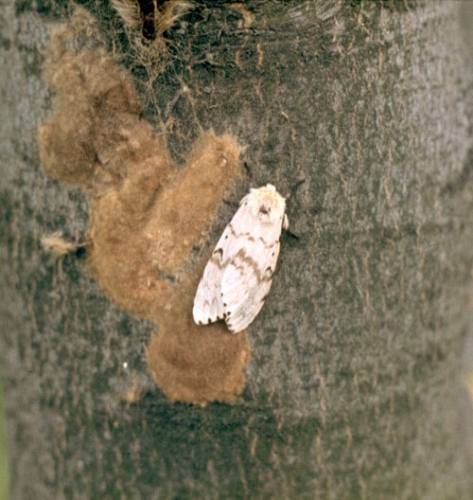Gypsy moth caterpillars damaging spruce trees
Spruce trees provide haven for low populations of gypsy moth.
The last few weeks of June, I received about a dozen calls from people very anxious about caterpillars feeding on their plants. Mostly the caterpillars were on oaks and fruit trees, but four of these calls were from people that had caterpillars feeding on spruce trees. A Monroe County resident contacted the MSU Garden Hotline in a panic because the tops of two spruce trees were stripped of needles. During the last three years, this same type of damage has been showing up in Washtenaw County. The caterpillars damaging the trees in Monroe County were gypsy moth caterpillars.
|
Over 15 years ago it was a common occurrence across Michigan to see this same insect eating the foliage off of oaks, birches and many other trees including spruce. Today, it is unusual to find large numbers of gypsy moth caterpillars attacking plants. A fungal disease called Entomophaga maimaiga has become a very important natural control in limiting the development of gypsy moth populations. The fungus attacks and kills the caterpillars in midsummer, leaving them hanging straight down on tree trunks. The fungus is effective even in sites where as few as five larvae per acre are present, according to research from the University of Massachusetts.
Entomophaga can be found across Michigan, where it grows and infects caterpillars during periods of consistent rainfall in late spring and early summer. The weak link for this pathogen is moisture and humidity. If rainfall is low, it will reduce the effectiveness of the fungus, allowing populations of the moth to grow. Unfortunately, much of Michigan has experienced an extended dry period over the last few weeks.
A recent trend seen in many counties in southeast Michigan is for gypsy moth populations to live at low levels in blue spruces. The close growing branches and sharp needles protect caterpillars from many predators. The pest seems to have found a niche surviving in the spruces. These low level populations can surge if dry conditions prevent development of the fungus. Some years we have seen serious damage to spruce trees caused by gypsy moth caterpillars.
Currently, gypsy moth caterpillars have started to pupate (process to change into a moth) in the southern counties in Michigan. For the rest of the state, caterpillars are still feeding on trees and shrubs; inspect pines and spruces for caterpillars. Most trees are fed upon by a variety of insects each summer, but for spruces and pines it is a serious stress to lose foliage and, unlike deciduous trees, this foliage is not totally replaced yearly.
In the next few weeks, moths will emerge and begin to mate. The beautiful, white female moth does not fly and can be seen on branches, under eaves, on lawn chairs or virtually on anything that is not moving in the landscape. The brown male moths will be fluttering across forests, orchards and landscapes, seeking out female moths to mate and complete their lifecycle. Before dying, female moths as in the picture above lay their buff-colored eggs.
Late summer on into autumn is a great time to go hunting for the buff-colored egg masses. If you have spruces, check under the branches for the egg masses. If you find egg masses on structures, outdoor furniture or trees, knock them off into soapy water. This sanitation practice reduces the number of caterpillars the following year. Some of their favorite trees include oak, birch, apple, willow, hawthorn, white pine, blue spruce, serviceberry and poplar, but they will eat leaves from maple and other trees that are not their most preferred species. The greatest risk is to evergreens like blue spruce and white pine that do not come back from defoliation as well as deciduous trees. Inspection now, especially in the spruces will give you insight for possible control measures needed yet this year or possibly next spring.
For more information related to gypsy moths, contact the MSU Garden hotline toll free hotline at 888-678-3464 or visit the University of Massachusetts Amherst Extension website.
Detailed information on Entomophaga, see MSU Extension Bulletin E-2604, Entomophaga maimaiga – A Natural Enemy of Gypsy Moth.



 Print
Print Email
Email
